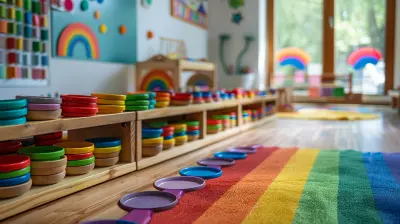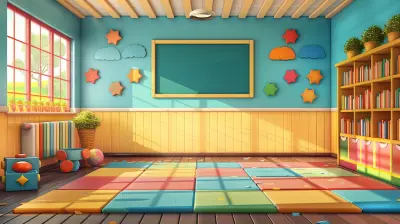18 August 2025
Who says learning has to be a solo journey with your nose buried deep in a textbook, half-asleep, and dreaming of pizza? 😴🍕 Let’s flip that script! Imagine a classroom buzzing with chatter (the productive kind), students leaning over to help each other, lightbulbs going off left and right — that’s the magic of peer teaching through collaborative activities.
You see, students teaching each other isn't just warm and fuzzy feel-good stuff. It’s backed by some serious pedagogy and makes learning waaay more effective and fun. So, grab your coffee or whatever fuels your brain, and let’s dive into how we can turn classrooms into collaborative learning playgrounds!
What Is Peer Teaching Anyway?
Before we get all jazzed up about peer teaching, let’s break it down real quick.Peer teaching is when students take the wheel and help each other learn. That could mean tutoring, explaining a concept, or even leading a small group activity. It can be formal (like a project) or informal (like helping your buddy understand fractions without wanting to cry 😅).
The cool part? Both the teacher and the learner benefit. Teaching someone forces you to deeply understand the topic, and hearing explanations from someone who just got it can sometimes hit the sweet spot better than a textbook.
Why Bother? The Mind-Blowing Benefits of Peer Teaching
Still skeptical? Let’s talk perks. Peer teaching isn’t just about making your life as an educator easier (though it does that too). Here's why it rocks:✔️ Deeper Understanding
Ever heard the saying “You don’t really understand something until you can teach it”? There’s truth in that. When students prepare to explain something, they start asking the right questions and connecting dots like knowledge ninjas. 🥷📚✔️ Builds Confidence
There's something empowering about going from “I hope I don’t get called on” to “I got this, let me explain it to you.” That confidence boost? Priceless.✔️ Promotes Active Learning
Instead of passively absorbing info (aka slowly zoning out), students engage actively. They're thinking, questioning, solving, and—most importantly—talking.✔️ Supports Social-Emotional Skills
Collaboration teaches empathy, patience, communication... you know, the stuff robots can’t do. 🤖❤️✔️ Reinforces Classroom Community
Helping each other out builds trust and a sense of “we’re in this together.” It’s like academic teamwork with less sweat and more brainpower.
Okay, So How Do You Get Peer Teaching Rolling? 😎
Ah, the juicy part! Here’s how to get collaborative peer teaching off the ground without tearing your hair out.1. Create the Right Environment
You can’t just yell “teach each other!” and hope for the best. Creating a learning atmosphere that’s open, respectful, and safe is key.Tip: Start with team-building exercises and set ground rules. Make sure students know it’s okay to make mistakes — heck, encourage it. Learning = failing forward.
2. Mix Up the Groups
Seriously, don’t just let students pick their besties every time. Sure, Susan and Jenny might be inseparable, but Eduardo may have killer math skills that could really help Jenny level up.Try rotating mixed-ability groups that shuffle weekly or bi-weekly. Keep it fresh, keep it fair.
3. Assign Roles
Ever been in a group project where one person did everything and the rest just vibed? Yeah, don’t do that.Give students specific roles — like “question asker,” “note taker,” or “time manager.” It brings purpose and accountability, and no one gets left behind staring into the void.
4. Use Collaborative Tools
Whiteboards, sticky notes, Google Docs, mind maps… the options are endless. Digital or analog, give students tools to brainstorm, present, and build knowledge together.Bonus: teaching each other through visual aids is not only helpful, it’s also Instagram-worthy. #StudyGoals
5. Encourage “Think-Pair-Share” Moments
This classic method is the PB&J of active learning.- Think: Pose a question or problem.
- Pair: Let students work it out with a partner.
- Share: Open it up for discussion.
Perfect for breaking the ice and warming them up to teaching each other.
6. Peer Instruction With a Twist
Got a math problem or a tricky grammar rule? Let students work it out in small groups, then have a “student-expert” explain it to the class.Bonus idea: have students create their own mini-lessons. Crazy? Maybe. Effective? Totally.
Brilliant Collaborative Activities That Encourage Peer Teaching
Let’s be honest, the success of peer teaching depends 99.9% on the stuff you actually do in class. So here are some quirky, engaging, and brain-boosting collaborative activities.🧠 1. Jigsaw Method
No, not the creepy horror movie character. This one's way more educational.Here’s how it works:
- Split a topic into sections.
- Assign each student a section to “master.”
- They join others with the same section, research/discuss it…
- Then go back to their original group to “teach” what they learned.
Like a puzzle, each piece (student) brings something essential to the table.
🗣️ 2. Peer Debate Panels
Want students to really understand a topic? Make them defend it.Set up small groups and assign them positions on a topic. They research, prepare arguments, and present. Then switch sides. Bam — instant empathy and critical thinking.
✍️ 3. Collaborative Note-Taking
Here’s a fun twist: students collectively create classroom notes. They can use a shared document or poster. Divide it by topic, and let everyone contribute during or after the lesson.Think of it as a crowdsourced study guide. Genius, right?
🎭 4. Role-Reversal Day
Let students become the teachers for a day. They can present a topic, run a quiz, or even set up a game. Give them a rubric, support them, then watch the magic unfold.Letting them step into your shoes — even briefly — builds a whole new appreciation for teaching (and just might make them stop asking for extra credit every five minutes).
🎲 5. Game-Based Learning
Turn review sessions into a peer-led game show. Think Jeopardy, Kahoot, or Bingo — but have the students design the questions and run the show.Cue competitive spirit, collaborative learning, and some solid laughs.
Common Pitfalls (And How to Dodge Them Like a Classroom Ninja)
We’re all about that #RealTalk here — peer teaching has its hiccups. Here’s how to sidestep them gracefully.❌ Uneven Participation
Fix: Use structured roles and switch things up often. Everyone contributes, or no one “wins” (figuratively, of course).❌ Misinformation Spread
Let’s face it — students aren’t perfect (shocker!). They might explain it… wrong.Fix: Always circle back for clarification. Use quick mini-reviews or check-ins to make sure knowledge is on point.
❌ Shy or Resistant Students
Not every kid's thrilled to teach or work with peers.Fix: Build up slowly. Start with low-pressure activities and offer choices. Confidence is contagious.
Assessment Isn’t the Enemy: Peer Evaluation FTW 💯
You don’t need to whip out a pop quiz to see if peer teaching is working. Peer assessment is powerful (and surprisingly fun).Let students give feedback on each other’s explanations or group contributions. Use rubrics, emoji charts, or simple “two stars and a wish” formats. Keep it constructive, not cutthroat.
Wrapping It Up With a Bow 🎁
Encouraging peer teaching through collaborative activities isn’t just another fancy item on your education checklist — it’s a total game-changer. Think of it as teaching with super glue: everything sticks better because students are doing the heavy lifting themselves.Whether it's through clever grouping, structured activities, or simply letting students explain their "aha!" moments, leaning into peer teaching builds stronger learners, deeper understanding, and a classroom that hums with conversation and curiosity.
So, next time you're planning a lesson, ask yourself: how can they teach each other? You might just find that the best teachers in your classroom are already sitting in the desks.








Aubrey Jordan
This article beautifully highlights the power of peer teaching. It's inspiring to see how collaborative activities foster not only knowledge sharing but also a deeper connection between students. This approach cultivates a supportive learning environment that benefits everyone involved. Thank you!
November 29, 2025 at 3:39 AM